
Dominoes are small rectangular blocks that can be stacked on end to form long lines. When one domino in a line is tipped, it causes the next domino in the row to tip, and so on, creating a chain reaction. These chains can take many forms, including straight lines, curved lines, grids that create pictures, and 3D structures like towers and pyramids. Dominoes can also be used to play a variety of games.
People of all ages enjoy using dominoes to make art and create patterns. A domino can be as simple or as complex as you want, but each piece must be properly spaced and positioned to work correctly. For example, if you place a domino so that it is parallel to a wall, the domino will not fall because it is blocking the path of gravity.
To create a domino art, you first design the desired pattern on a sheet of paper. Then you draw arrows that show the direction each domino should move. You may need to adjust the arrows as you go, especially if the arrow is pointing in a direction that would cause a domino to miss its intended target. After you’ve created your diagram, you can start to build your piece.
A domino can be made from wood or plastic, and it can have a number of different colors on the sides. Most dominoes have a white background, but some sets are painted in other colors. In addition, each domino is printed with a pattern of dots that resemble those on dice. Each domino is numbered on one side, and the other side is blank or marked with an arrangement of spots, called pips, that correspond to the numbers on dice. There are several different ways to mark the pips on a domino, but the most common is to use numbers from 1 to 6. Each set of dominoes has its own suit of numbers, and every domino in a given set belongs to at least one suit.
In a game of domino, each player takes turns placing a domino on the table. The domino must be positioned so that its matching ends are adjacent to each other and, if the domino is a double, they are touching fully in the center. The value of a domino is determined by the number of pips on its two matching ends, which can be added together to form a total.
When a player has a domino with a value that is higher than any other domino on the board, they win the game. In most games, the winning players are those who have the fewest pips in their remaining hands. The remainder of the game is played until all players have finished placing their last domino or until a player “chips out.”
Aside from being a fun and creative toy, dominoes can also teach children about gravity, sequencing, math, and pattern recognition. They can even inspire people to think about the power of one action leading to much greater — and sometimes catastrophic — consequences.